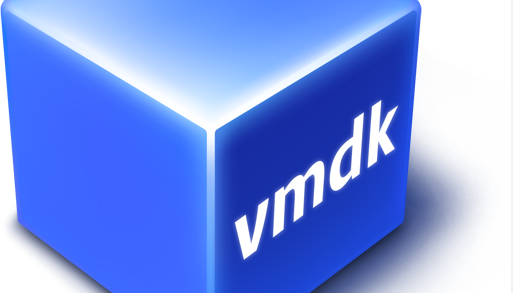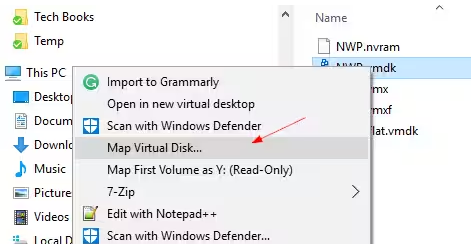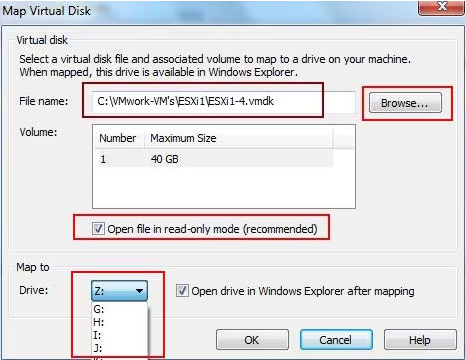A VMDK file is crucial for virtual environment, so it is needed to figure out what is VMDK file and how to mount VMDK file. This article provides you these two answer and also offer you with a further study on comparison of three virtual disk formats.

A VMDK (Virtual Machine Disk) file is a disk image format used by VMware virtual machines, and essentially a complete and independent virtual machines (VMs). It was developed by VMware, and its design allows for flexibility in how disk storage is managed for virtual machines.

1. Monolithic Sparse Disk
A Monolithic sparse disk is a type of virtual disk that doesn’t rely on a separate descriptor file to point to and describe the associated large data file. Instead, it combines both the descriptor and data into a single file. The descriptor, written in plain text, is embedded within the larger binary data file.
2. Monolithic Flat Disk
A Monolithic flat, unlike a sparse disk, is fully allocated at the time of creation. Which means that all space, including the start and end markers and all index nodes in between, is reserved from the outset. Although creating this type of disk takes more time, the investment pays off with faster performance compared to sparse disks.
3. Delta VMDK
A delta .vmdk file is created when a snapshot of virtual machine is taken. When is happens, the original flat.vmdk file switches to read-only mode, and all subsequent changes to the VM’s disk are written to the delta .vmdk file.
Although a VMDL File contains all information of a virtual machine, we rarely open it. However, there are some necessary situations we need to open it urgently, for example, when your virtual machine has crashed and is not booting correctly, you can still access the VMDK file to easily retrieve the contents of the virtual machine. Follow are several ways to open a vmdk file.
The simplest way to mount a VMDK file on a Window system is by using VMware Workstation Player. This dedicated virtualization software lets you directly mount VMDK files as separate volumes on your Windows system. Follow steps below, you can easily mount a VMDK file on your Windows system.
Step 1. Browse the location VMDK files directly.
Step 2. Right-click on the VMDK file and then click Map Virtual Disk.

Step 3. Click OK to finish.

Here are some simple steps to mount VMDK files in Oracle VirtualBox:
Step 1. Click New to create a new virtual machine. Use an existing hard disk file.
Step 2. Select the .vmdk file and then click Create.
Step 3. Click Start.
It’s a professional tool designed to access Linux file systems on Windows, you can also use it to mount the VMDK files. Following are some steps to mount a VMDK file.
Step 1. Click Mount Image in the menu and then click Containers. Click on VMware virtual disks and click Next.
Step 2. Navigate to the folder that contains VMDK files and click OK.
Virtual disks are available in various formats, determined by the virtualization software used to create them. Despite Virtual Machine Disk (VMDK), there are other two different types of popular virtual disk format, Virtual Disk Image (VDI) and Virtual Hard Disk (VHD). They all have their advantages, next is comparison to these three virtual disk formats.
Following are pros and cons:
VMDK
VDI
VHD
Note: Under conditions, conversion can be achieved among these three types of virtual disk format. E.g: Convert VHD to VMDK and vice versa, convert VDI to VHD and vice versa.
VMDK files are susceptible to damage, which can result in data loss for your virtual machines. So, there is an urgent need for your virtual machines to have a security assurance. Backup tool is just what you need, with a tool you can backup VMware datastore or you can backup all the virtual machines in VMware.
Use a professional backup tool is also important for your data security, AOMEI Cyber Backupis the tool can meet your need. It offers you an easy-to-use central console, with it you can achieve following requirement:
Agentless Backup: Create full, standalone image-level backups for entire VMware virtual machines without installing agents on each VM. Automated Backup: Configure a backup schedule, and backup tasks will automatically execute at the designated time. Centralized Management: You can manage all backups from a single interface. Perpetual Free: You can always use this free edition with no time limit.
You can click the following button to download the free version of AOMEI Cyber Backup.
Three easy steps to backup your VMware virtual machines:
1. Bind Device: Navigate to Source Device > VMware > + Add VMware Device to add a VMware host. And then add VMs by entering the host information.
2. Create Backup Task: Navigate to Backup Task > + Create New Task, and select VMware ESXi Backup as the Backup Type. Then set Task Name, Device, Target, Archive and Schedule.
3. Start Backup: Click Start Backup and select to Add the schedule and start backup now, or Add the schedule only.
(* If you need to enjoy more features such as Backup Cleanup, you can upgrade to Premium version.)
A VMDK (Virtual Machine Disk) file is a crucial component in virtualization environments, serving as the virtual hard disk for VMware virtual machines. It stores the data and system files required for a virtual machine to operate, effectively acting as a physical disk within the virtual environment. While VMDK files offer flexibility and convenience in managing virtual machines, they can be vulnerable to corruption or damage, making reliable backup and recovery solutions essential for safeguarding data integrity and continuity in virtualized systems. So in order to avoid data loss, it’s recommended you to backup virtual machines regularly.